Episode 196
What you’ll learn in this episode:
- How the artists represented by BABS translate their artistic vision to jewelry
- Why showing art and jewelry outside of the traditional gallery setting can make it less intimidating for non-collectors
- Why artist jewelry has yet to catch on with Italian consumers, and how Barbara hopes the industry evolves
- Why Barbara thinks there should be no division between art and art jewelry, and how she is trying to solve this issue
- What Barbara looks for in the pieces she selects for her gallery
About Barbara Lo Bianco
Barbara Lo Bianco is the CEO and Owner of BABS (Beyond Art Before Sculpture) Art Gallery in Milan, Italy. An art enthusiast with a long-time passion for artist jewelry, Barbara opened BABS in October 2018. As the first gallery in Italy dedicated to artists’ jewels, BABS collaborates with contemporary artists to create wearable art.
Photos:
Jessica Carroll, ring, “il volo” bronze
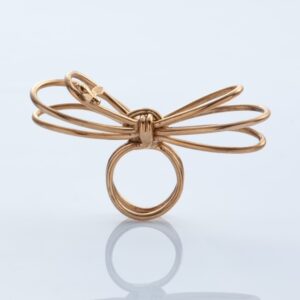
Alfredo Rapetti Mogol, earrings, “?!” titanium, gold, lapis
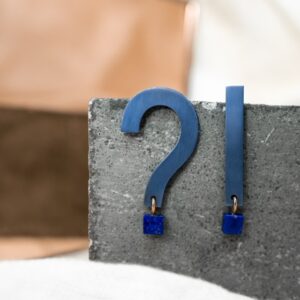
Davide Bramante, ring, “pentagon obsession”, bronze, oxidiane and rock cristal
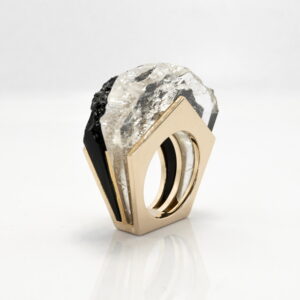
Daniele Papuli, necklace, “metrina”, paper and silver
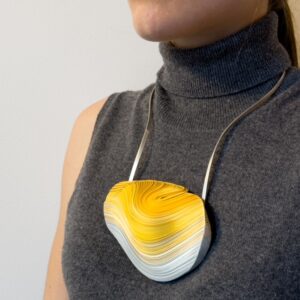
Alessandro Busci, necklace, “iceberg”, silver, gold, enamel, aquamarine
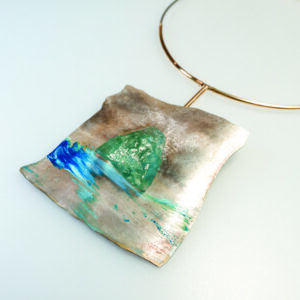
Chiara Dynys, ring, “a stone in a cage”, silver, bronze and amethyst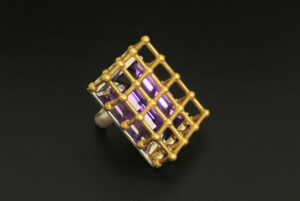
Alex Pinna, ring, “how deep is your love”, ebony and gold
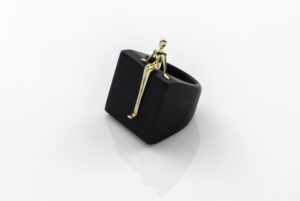
Additional Resources:
- Website: www.babsartgallery.it
- Artists Page: https://www.babsartgallery.it/maestri-gioiello-milano/
- Barbara’s LinkedIn: https://www.linkedin.com/in/barbara-lo-bianco-a1330a/
- Instagram: https://www.instagram.com/babsartgallery/
- Facebook: https://www.facebook.com/babsartgallery.gioiellidartista/
- Twitter: @BabsGallery
Transcript
Barbara Lo Bianco’s mission is to smash the arbitrary line that divides art and jewelry. As owner of BABS (Before Art Beyond Sculpture) Art Gallery in Milan, she works with fine artists to create their first pieces of jewelry and translate their vision to a new medium, breaking all the rules of what art or jewelry are supposed to be. Barbara joined the Jewelry Journey Podcast to talk about how she’s trying to change the way art jewelry is displayed at fairs; the types of artists she likes to represent; and some of her favorite pieces from BABS. Read the episode transcript here.
Sharon: Hello, everyone. Welcome to The Jewelry Journey Podcast. This is the first part of a two-part episode. Please make sure you subscribe so you can hear part two as soon as it’s released later this week.
We’ve had a lot of entrepreneurs on The Jewelry Journey. Barbara Lo Bianco is an entrepreneur, but in a different category. Her forays before art and jewelry and having a gallery were in unrelated fields. She was involved in a fitness center and was a real estate investor, but her passion has always been in art and jewelry. BABS stands for Beyond Art Before Sculpture. She opened a gallery which showcases artists she knew. They were doing sculpture, but she convinced them to do jewelry. They didn’t know their creativity was also in this area until she gave them the space and encouragement to do it. We’ll hear all about her art gallery today.
Barbara: Hello, Sharon. Thank you for having me again.
Sharon: I’m so glad that we connected. Why did you decide to locate in Milan?
Barbara: It’s very normal. It’s just that I live here. It’s the easiest thing. Milan has a long tradition in artist jewelry. Actually, artist jewelry in Italy started in Rome right after World War II, when some of the sculptors were commissioned to do unique pieces in order to recreate an interest in our jewelry, which was not something necessary right after the war, when everything had to be reconstructed again. So, you had to make jewelry that was a little bit different.
Then, in the 60s, it moved to Milan. In Milan, there was GEM by Montebello, who has been the biggest and most famous editor of jewelry by artists in Italy. They worked with more than 50 artists and created more than 200 jewelry pieces. So, there is a tradition, but there had never been a gallery doing that. So, I was in Milan. Why not? Actually, I’m still the only gallery in Italy.
Sharon: In Italy?
Barbara: Yes.
Sharon: I’m thinking about Thereza Pedrosa. She gathers pieces she likes, not pieces that have been commissioned for the gallery.
Barbara: Yeah, this is a little bit different. We don’t focus on contemporary; we focus on jewels made by artists, visual artists, painters, sculptors, photographers. We ask them to do a piece of jewelry. We also exhibit some historical pieces, but it’s not our major business.
Sharon: I was wondering if you live in Milan. I don’t know that much about Italy, but I’ve heard Milan is the fashion capital.
Barbara: It is. It’s so busy.
Sharon: Did you have a reason to start there?
Barbara: It’s the most motivational and vibrant city in Italy. It is very European, although in size, it’s quite nice. It still has a local atmosphere although it’s quite international. The other cities in Italy are more for tourists. This is one is more a business city, and it’s more where you do things. It’s the most business city we have, but it’s nice.
Sharon: I’ve heard it’s an up-and-coming city. It was industrial and now it’s really changed.
Barbara: Yes, in the 70s, it used to be a little bit more industrial. Now, it’s mainly services.
Sharon: Was that one reason you decided to open in Milan, besides the fact that you lived in Milan? Did you consider other places?
Barbara: No, honestly, I did not. I think it is quite a good location because a lot of the expertise, especially for goldsmiths, is in this area anyway. I would have had to work mostly from here. Plus, it is quite convenient if you do road shows or if you want to do exhibitions. It’s very logistically easy. There are some cities in Italy which might be a little bit more artistic, like Florence or Venice or Rome, but I still think working in Milan would be the best place.
Sharon: Did you consider other artists you didn’t know, or artists that were in other parts of Italy?
Barbara: Oh, yes. We do work with them. I started with just a few whom I knew. I had been buying their work because I am an art enthusiast. I did buy some pieces of artists I liked. That was just the beginning, but I’m still working and starting to get work from other artists, not only Italians, but also foreigners.
Sharon: Did you find it difficult to start because they didn’t know who you were?
Barbara: Yes. I have to say yes, because at the beginning I was totally new and a very young gallery. It was the only gallery doing this in Italy, so it was quite strange to approach an artist and ask, “Excuse me, would you like to do this?” Second, it was because I don’t come from the art world. I’ve not been in the system. My husband is not a collector. He’s not a gallerist nor is my family. We’ve always been very enthusiastic about it, but we’re not related to anyone and haven’t worked with museums or galleries. So, connections were not that easy at the beginning.
I’m usually a little bit humble, but this time I have to say it because I’ve been having a lot of appreciation lately. I’m working a lot and trying to work well and consistently, so people are now approaching me, and once I approach them, they’re willing to work with me. So, it’s getting easier.
Sharon: What did you do during Covid, when nobody would talk to anybody?
Barbara: Well, we needed to work. We worked at trying to build up an archive. We were organizing, taking pictures and trying to exploit social media and what technology gave us. We were quite a young gallery because we opened in the autumn of 2018. After a year and a half, we were already closed for the pandemic, but that gave us some time to slow down a little bit. We had been doing exhibitions every two months, which was a lot. So, we had time to slow down and reorganize the archive, reorganize the website, reorganize the Instagram, and try to understand how all those types of media work, because I had never been using them. I didn’t need them in my previous business. So, there was everything to learn.
Sharon: Is this what you focus on mainly, besides the gems? Have you given up the gems? Have you given up the real estate investing? Is this your main business?
Barbara: No, this is my main business. I gave up fitness. I’m still doing real estate and financial investments because that’s a family company. I work for them, but that doesn’t take too much time. I have to say that the gallery absorbs 90% of my working time.
Sharon: Wow! Do you have people who work for you in the gallery?
Barbara: Yes, I have a couple of assistants.
Sharon: How do you find new artists? Do they submit things to you?
Barbara: Sometimes they submit them. Sometimes I work with curators and consultants. I explore new artists and try to see what’s new in this world, plus I go to classes. I’m doing a class with an art historian with a focus on contemporary artists. So, I see the artists I like or artists I might find interesting for what they have to say. I always get inspiration.
Sharon: Is that an official class, or is that something you do because you like to?
Barbara: No, that’s just because I like to. At this time in my life, I’m doing things just because I like them. It’s always been an interest, so I want to pursue it; I want to do it. I do study a lot of art because that’s not my background. My background is in law and then taking classes for an MBA. I’ve been working in a totally different field, so there’s always a need to learn more. Of course, I’ve grown up surrounded by art, but that’s mostly ancient art. That helps you build a critical eye and makes you a little more curious about exploring things, but somehow you have to continue pursuing what you like. So, I do study.
Sharon: Do people send photos to you of things you’ve never heard of?
Barbara: Yes, artists do propose. There are not that many, I have to say. They propose themselves mostly if they are emerging artists. A lot of contemporary jewelers do promote themselves, but I do not work with them most of the time because that’s not my business. That is a very nice type of art, but it’s not what I’m focusing on. What I do in the gallery is work with regional artists that usually do not do jewelry. I ask them to create something with their poetic position, with their aesthetic eye, with their meaning, and with the message they usually try to correlate with their art. I propose that they exploit a new medium to convey the same type of art, which is a small sculpture.
Sharon: Do they understand what you’re after?
Barbara: Yes.
Sharon: And if you’re low on rings or bracelets, let’s say, and you need more, you don’t tell them that.
Barbara: No, usually not. I ask them to do something and leave them free—at least at the beginning, I let them feel free to explore, to draw, to create a prototype in paper, in concrete, in clay, in wax, in whatever they like. That’s a starting point. From that starting point, we start creating things. Maybe we say, “O.K., this one doesn’t work as a bracelet, but maybe we can transform it into a necklace or into a pendant,” or “This doesn’t work as a ring, but it could be an earring or vice versa.” It depends.
Sharon: Are they open to your changes, if you have changes?
Barbara: Sometimes yes, sometimes no. If they do not want to change the work, but the work is not wearable, sometimes we discharge that project. We do another thing.
Sharon: If it’s not wearable?
Barbara: Yeah, because there are some limitations. If you want to create a ring in gold and in a particular size, but it doesn’t fit because it would be way too heavy, then I cannot make it. If you want to make an earring and it weighs too much so that your ear falls down, there is no way we can do an earring. We can do something else, or we can change the material and try to find something lighter. Sometimes they do accept it; sometimes we just don’t do that piece.
Sharon: You mentioned that you like the fact that you can show your art and jewelry in different places where you don’t usually see it, like a gym.
Barbara: Since I’ve always been passionate about art, I’ve always thought people are quite shy about walking into a regular art gallery, especially in Italy. You have some sort of fear. “What if they ask me to buy it and I cannot afford it? What if I don’t understand and I ask the wrong question?” Especially with contemporary art, it’s always harder to approach it.
I had a chain of very high-end fitness centers. Very nice people were coming to the gym, and they were coming quite often. I had a lot of walls, so I said, “Why not exhibit some young artists or some contemporary artists?” I did, and it was appreciated by other people. They did approach the art and they liked it. Twice a year, I was doing a bigger exhibition with sculptures. For the rest, I was just exhibiting flatworks. It was quite a successful experience for everyone. We had nicer spaces for the clients that were seeing something new, and the artists sold pieces quite a few times. It was a win/win situation.
Sharon: Wow! We will have photos posted on the website. Please head to TheJewelryJourney.com to check them out.

